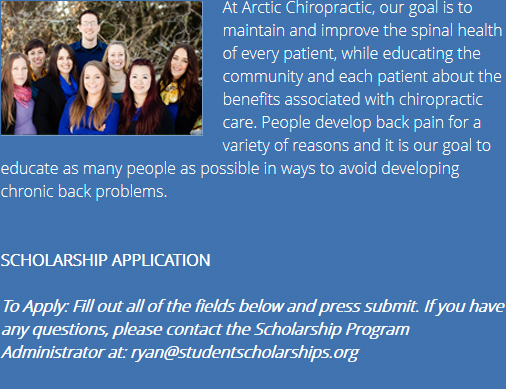Juneau Chiropodist

Juneau Chiropodist - Distortions of the spinal column referred to as the vertebral subluxation complex could result in spinal nerve damage. Oftentimes, the vertebral subluxation complex is painless, yet could result in interference between the bodies connection with the brain, affecting the muscles, spine, nerves, discs and organs. Chiropractors are trained and educated to correct and detect the vertebral subluxation complex. This improves overall wellbeing by restoring the lines of communication along with the brain and enhancing the body's natural healing potential.
Many chiropractic treatments can help to lessen back pain and pains in the extremities by using many specific methods like for example spinal manipulations to unlock stiff joints and reduce spinal nerve irritation: workplace injuries, stress, accidents, poor posture, and pregnancy, to name some. Some chiropractors specialize in particular types of injuries, like sports injuries. Professional sports players and amateurs are all susceptible to the same types of injuries, like calf and hamstring strains, thigh and groin strains, Achilles tendon injuries, neck and lower back pain, and shoulder sprains.
Chiropractor utilize hands-on techniques to lessen back pain and enhance movement in the spinal column, so that day by day tasks would feel a lot more comfortable. Chiropractor can offer guidance on correct posture, and specific ways to lift and bend without triggering spinal conditions.
Chiropractors work with the vertebrae of the spinal column, which number C1 to L5. The following list indicates what organs, body functions and nerve each vertebra connects to:
C1: pituitary gland, scalp, face bones, brain, sympathetic nervous system, ears, eyes, inner and middle ear
C2: auditory nerves, optic nerves, eyes, sinuses, heart, mastoid bones, forehead, tongue
C3: cheeks, outer ear, trifacial nerve, face, teeth, lungs
C4: eustachian tube, nose, lips, muscle membranes, mouth, lungs
C5: pharynx, vocal cords, neck glands
C6: tonsils, neck muscles, shoulders
C7: elbows, thyroid, shoulders
T1: hands, arms, fingers and wrists, arms below the elbows, trachea, heart and esophagus
T2: heart valves and coronary arteries, bronchial tubes, lungs
T3: chest, breast, lungs, bronchial tubes, pleura, heart
T4: gallbladder, heart, lungs, common duct, bronchial tubes
T5: solar plexus, general circulation, liver, heart, esophagus, stomach
T6: liver, duodenum, stomach, peritoneum, esophagus
T7: kidneys, ovaries, uterus, appendix, testes, spleen, adrenal cortex, large intestine, pancreas
T8: small intestine, pyloric valve, stomach, spleen, gallbladder, adrenal cortex, liver, pancreas
T9: adrenal cortex, ovaries, uterus, pancreas, spleen, gallbladder, small intestine
T10: ovaries, uterus, kidneys, testes, adrenal cortex, appendix, large intestine, spleen, pancreas
T11: adrenal cortex, kidneys, adrenal medulla, large intestine, urinary bladder, uterus, uterus, ovaries, ileocecal valve
T12: small intestine, large intestine, urinary bladder, ileocecal valve, lymph circulation, uterus, kidneys
L1: large intestine, uterus, inguinal rings
L2: upper leg, appendix, urinary bladder, abdomen
L3: knee, prostate, sex organs, large intestine, uterus, bladder
L4: prostate gland, lower back muscles, sciatic nerve
L5: prostate, lower legs, feet, ankles
The coccyx connects to the anus and rectum, while the sacrum connects to hip bones, buttocks, rectum, sex organs, ureter, prostate, genitalia, urinary bladder.
-
Orthotics Juneau
Orthotics Juneau - Custom orthotics are made for a particular person's feet for the reason of correcting any misalignments. Custom orthotics can improve posture, and alleviate leg or foot pain. Custom orthotics could be inserted in a shoe. They ... More -
Foot Clinic Juneau
Foot Clinic Juneau - The number of motor vehicle accidents in Canada number over 8,000,000 per year. Nearly all victims of low-impact car accidents normally do not seek any medical attention. Of these more than 60% report no injury. This is ... More -
Chiropodist Juneau
Chiropodist Juneau - Stress reduction in conjunction with healthy daily life is an important part of preventive health. Preventive health means maintaining overall health so as to avoid the onset of conditions and diseases. Though some stress or ... More -
Podiatrist in Juneau
Podiatrist in Juneau - Scoliosis is a spine-related deformity resulting in a sideways curvature to develop. The spinal deviation should be more than ten degrees for a diagnosis of scoliosis to be made. That is because a slight deviation in the ... More -
Back Pain Juneau
Back Pain Juneau - EMS or likewise known as Electrical Muscle Stimulation is a treatment for injuries by sending electrical pulse utilizing the square form to the muscle needing treatment. The square waveform could stimulate the muscles giving ... More
STUDENT INFORMATION
Site Links
Arctic Chiropractic Juneau
2243 Jordan AveJuneau , Alaska 99801
Phone: (907) 416-4094
Fax: (907) 313-6812
All Rights Reserved.
All Rights Reserved.









